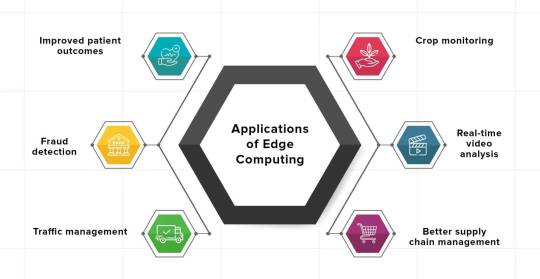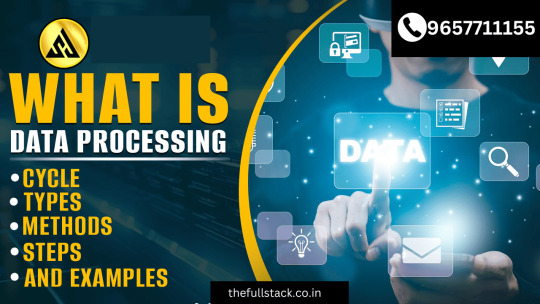#DataProcessing
Explore tagged Tumblr posts
Text
EnFuse Solutions Delivers Reliable Data Management Solutions to Optimize Your Business Performance

EnFuse Solutions offers reliable data management services to boost business performance. Their expertise includes data profiling, enrichment, standardization, and migration, ensuring clean, accurate, and actionable data. Trust EnFuse Solutions to streamline your data processes and enhance operational efficiency across your organization.
Boost efficiency today with EnFuse Solutions’ proven data management services: https://www.enfuse-solutions.com/services/data-analytics-services/data-management-services/
#DataManagement#DataManagementServices#DataGovernance#DataQuality#DataProcessing#DataManagementCompanies#DataManagementIndia#DataManagementServicesIndia#EnFuseSolutions#EnFuseSolutionsIndia
0 notes
Text
Exploring the Advanced Applications of Edge Computing and Its Real-world Impact
Edge computing processes data closer to the source, reducing latency and enabling faster decision-making. This technology is transforming industries by enhancing performance in autonomous vehicles, smart cities, and industrial IoT. In healthcare, edge computing ensures real-time patient monitoring, while in retail, it improves inventory management and personalized customer experiences. Additionally, it boosts security in surveillance systems by enabling faster anomaly detection Read More

1 note
·
View note
Text

Woman In A Male World
The year was 1989. I was a female computer tech. As Computer Production Coordinator, my job included troubleshooting computers, printers, and Internet connections for 103 employees and thousands of students who might call our 3 busy phone lines for help. Sometimes I could walk them through dialing into the library catalog via modem. Other problems, I had to go to their desk.
That particular day, a gentleman was on the phone demanding I replace his Mac computer, that simply 'wasn't working.' He asked for my boss, who was not at his desk. This didn't surprise me at all. The Systems Department at Georgia Tech was very busy. My hard-working boss often had to go to meetings with other departments or the library administration. The unfortunate man called back and got me again. My attempts to ask him the standard questions didn't get me enough information to figure out what exactly the problem was. So, I dropped everything and went to his desk.
He showed me how he moved the mouse and the cursor stayed in one spot.
I lifted the mouse and the problem was embarrassingly obvious. "Your mouse ball is dirty. I think if we clean it, your Mac will work just fine."
He grew very impatient with me as I turned the mouse over, put pressure on the spring-loaded plastic ring, and turned it to release it. I carefully showed him each step so he could do this himself.
We went into the rest room and I washed the mouse ball with the bare minimum of soap from the dispenser on the wall. Just a drop. I lathered it up and rinsed it very thoroughly, then wrapped it briefly in a paper towel. I repeated this until the ball was absolutely dry.
We walked back to his desk, and I carried some wet paper towels to clean the area where he used the mouse. At that time, no one in the library had a mouse pad. We used our mice on the desks. Dust was rampant. His desk had quite a layer of dust and it took many paper towels, wet and then dry, to get it clean.
The mouse worked perfectly. He stopped his complaints. I wished him a nice day.
That was one of two negative experiences I had in probably hundreds of personal visits over the year and a half I worked in Systems. The vast majority of employees, male or female, were friendly and didn't mind me being female and working to fix their computer problems.
Employees in the library were about evenly split between males and females. When I started working in Systems, there were 6 of us. I was one of 3 females. In the Systems Department, there was absolutely no discrimination against us females. We got a lot of work done.
I don't think I ever had a computer problem to fix in that department again. The rudeness of that fella did hurt, but at least I didn't have to deal with him again. Most people greeted me with a smile and let me show them how to keep their equipment running longer. And, wanted to learn.
Today, things are changing in a bad direction. Salaries for females have never been equal to a male in the same position. People of color also experience this, versus a white male. I am sad to see this war on DEI. People should know that DEI means, Diversity, Equity, and Inclusion. It doesn't mean you select unqualified people just because they are female, or a person of color, or a disabled person. It means, you have to consider qualified people in those categories.
Some politicians would tell you that there aren't enough people who are female, or a person of color, or a disabled person, who are qualified, who deserve to be considered.
I disagree. Both women I worked with in System were Black. They were both just as intelligent as I was, and just as hard-working as any man in our department. All of us worked together as a team. All of us worked hard. All of us were pretty intelligent. Stupid people aren't as good at troubleshooting computers or being 'techy'. Intelligence is a measure of how well you can solve difficult problems.
Don't get me wrong, I'm not saying intelligence is a measure of worthiness or value as a human being. I've known people with disabilities in the intelligence category who were warm, pleasant, and valued humans in my life. One of the housekeeping staff in the University Of Utah Library comes to mind. Everyone loved him. He worked hard at his job to keep the library clean. By the way, he was white.
But, I give this example, of my job that required me to be intelligent, and the two women who enriched my life and taught me how to be a computer tech. Men in the department also taught me and were kind. As I said, we worked as a team. Our diversity never interfered with the work, or with our ability to discuss it and solve daily problems.
DEI is not a problem, but the lack of it definitely is. Beware of lies from politicians!
Photo from Pexels.com pexels-mizunokozuki-12903276.jpg
#DEI#GovernmentWorkers#politicians#governmentemployees#work#jobs#discrimination#intelligence#dataprocessing#computers#troubleshooting#diversity#women#technical#personal experiences
0 notes
Text
Achieve Data Mastery with EnFuse Solutions' Premier Data Management Services - Empower Your Business Success!

Unlock the full potential of your data with EnFuse Solutions' premier data management services. They specialize in data enrichment, cleansing, validation, and standardization, ensuring accuracy and consistency across your datasets. Explore how EnFuse Solutions’ data management services can enhance your business data’s potential and fuel success-visit this link: https://www.enfuse-solutions.com/services/data-analytics-services/data-management-services/
#DataManagement#DataManagementServices#DataGovernance#DataQuality#DataProcessing#DataManagementCompanies#DataManagementCompanyinIndia#DataManagementServicesIndia#EnFuseSolutions#EnFuseSolutionsIndia
0 notes
Text
Boost efficiency with our comprehensive data entry services tailored for diverse industries. Ensure accuracy, speed, and security with expert data management. From finance to healthcare, we streamline operations with high-quality data solutions. Outsource data entry services today and enhance productivity with our reliable, cost-effective support. Transform your data management now!
#DataEntryServices#DataEntry#DataManagement#DataProcessing#DataQuality#DataAccuracy#DataEntrySolutions#BusinessEfficiency#Outsourcing#VirtualAssistant#DataEntryExperts#DataEntrySupport#DataEntryProfessionals#DataEntryOutsourcing#DataEntryTasks#DataEntryJobs#DataEntrySpecialists#DataEntryCompany#DataEntryAutomation#DataEntryTrends#DataDriven#BusinessSolutions#AdministrativeSupport#DataOrganization#DataEntrySkills#DataEntryIndustry#DataEntryWork
0 notes
Text
Unlocking Business Growth with Data Science: Strategies for Success
Data is a powerful asset, and at Samvinmaya Innovations, we help businesses harness its full potential through advanced data science solutions. Our expertise includes data mining, statistical analysis, machine learning, and data visualization, allowing businesses to make smarter, data-driven decisions. We specialize in predictive analytics, anomaly detection, and customer segmentation, providing actionable insights that optimize business performance. Whether it’s real-time data processing, big data analytics, or business intelligence, we craft solutions that enhance operational efficiency. Our team works with structured and unstructured data, ensuring businesses extract meaningful insights regardless of data complexity. We implement AI-driven automation in data pipelines, reducing manual effort and improving accuracy. Our commitment to data security and compliance ensures that businesses can trust us with their most valuable digital assets while staying compliant with industry regulations.
#DataScience#DataProcessing#DataAnalytics#DataVisualization#DataMining#MachineLearning#DataScienceSolutions#SamvinmayaInnovations#Technology
1 note
·
View note
Text

BCC-United doesn’t just manage data—we elevate it. Structured, optimized, and insight-driven, we turn data noise into strategic power, fueling smarter operations, sharper insights, and stronger business outcomes. 📊 📈 🗂️
#DataTransformation#DataAnalytics#DataScience#DataManagement#DataDrivenDecisions#BusinessIntelligence#BusinessInsights#BusinessGrowth#DataTransformationServices#DataCleaning#DataIntegration#DataProcessing#Typography#Minimaldesign#Digitalillustration#SoftwareDevelopment#SoftwareCompany#SoftwareSolutions#BCCUNITED
0 notes
Text
BPO Solutions & Data Entry Management Services by Sphere Global Solutions
In today’s fast-paced business environment, data plays a crucial role in decision-making, operational efficiency, and strategic planning. Managing vast amounts of data requires accuracy, security, and seamless processing. Sphere Global Solutions offers comprehensive BPO solutions and data entry management services to help businesses streamline operations and improve productivity.
Our Data Entry & Management Services
✅ Accurate Data Entry Ensuring precise and error-free data entry to maintain data integrity and reliability. Our team is equipped with the latest tools and technologies to process information quickly and efficiently.
✅ Data Processing Transforming raw data into meaningful insights through structured processing, ensuring better accessibility and usability.
✅ Database Management Organizing, storing, and maintaining databases efficiently to enhance data security and retrieval speed. Our solutions optimize data structure for seamless access and management.
✅ Document Management Digitizing, indexing, and managing documents to ensure quick retrieval, secure storage, and efficient workflow automation. Our document management solutions help businesses reduce paperwork and improve efficiency.
✅ Data Analytics & Reporting Leveraging advanced analytics to derive actionable insights from data, enabling businesses to make informed decisions and drive growth. Our data reporting services provide accurate and timely analysis for various business needs.
✅ Industry-Specific Data Entry Customizing data entry services to meet industry-specific needs, ensuring compliance, accuracy, and efficiency across different business sectors. We cater to industries like healthcare, finance, retail, logistics, and more.
✅ Quality Control & Assurance Implementing rigorous quality control measures to ensure the highest level of accuracy and consistency in data entry and processing. Our multi-layered verification process guarantees error-free data management.
Why Choose Sphere Global Solutions?
🔹 Expertise & Experience: With years of experience in BPO and data management, we provide top-tier solutions tailored to business requirements. 🔹 Advanced Technology: Utilizing the latest automation and AI-powered tools for accurate and efficient data handling. 🔹 Cost-Effective Solutions: Reducing operational costs while ensuring superior quality and compliance. 🔹 Security & Confidentiality: Implementing robust security measures to protect sensitive data from breaches and unauthorized access. 🔹 Scalability & Flexibility: Offering customized solutions that scale with your business needs, ensuring efficiency at every stage of growth.
Partner with Us for Efficient Data Management
Enhance your business efficiency with Sphere Global Solutions' BPO and Data Entry Management Services. Our tailored solutions ensure accuracy, security, and seamless data processing to help you stay ahead in a competitive market. Contact us today to explore how our expertise can benefit your business!
#BPOSolutions#DataEntryManagement#AccurateDataEntry#DataProcessing#DatabaseManagement#DocumentManagement#DataAnalytics#QualityControl#SphereGlobalSolutions
0 notes
Text
What is data management? Does it help your business to improve?
In today’s data-driven world, effective data management is not just a nice-to-have; it’s a necessity for any business that wants to thrive. If you want to implement or improve data management in your organization, consider partnering with a trusted expert in the field. EnFuse Solutions is one of the best data management companies in India, offering comprehensive services to help businesses harness the power of their data.
#DataManagement#DataManagementServices#DataManagementSolutions#EnterpriseDataManagement#DataQualityManagement#MasterDataManagement#DataSecurity#DataProcessing#EffectiveDataManagement#DataManagementBestPractices#SmartDataManagement#DataManagementCompanies#DataManagementIndia#EnFuseDataManagement#EnFuseSolutions
0 notes
Text
Apache Spark is a fast, scalable, and open-source big data processing engine. It enables real-time analytics, machine learning, and batch processing across large datasets. With in-memory computing and distributed processing, Spark delivers high performance for data-driven applications. Explore Spark’s features and benefits today!
0 notes
Text

#QuizTime If you could automate one business function, what would it be?
A) IT Support 👨💻 B) Customer Service 💬 C) Data Processing 📂 D) Workflow Management 📋
Comments your answer below👇
💻 Explore insights on the latest in #technology on our Blog Page 👉 https://simplelogic-it.com/blogs/
🚀 Ready for your next career move? Check out our #careers page for exciting opportunities 👉 https://simplelogic-it.com/careers/
#quiztime#testyourknowledge#brainteasers#triviachallenge#thinkfast#quizmaster#knowledgeIspower#mindgames#funfacts#itsupport#customerservice#dataprocessing#simplelogicit#simplelogic#makingitsimple#makeitsimple
0 notes
Text
What Is Data Processing: Meaning, Cycle, Types, Examples
Fundamentally, data processing turns unprocessed data into information that has significance. This is essential for handling and deciphering the massive daily inflow of data in the computer world. Data entry, validation, processing, and analysis are just a few of the varied duties involved. Information systems are built on data processing, which enables businesses to derive useful insights. Businesses can use this to track performance, make well-informed decisions, and gain a competitive edge. Decision-makers’ access to high-quality information is directly impacted by the accuracy and effectiveness of data processing. read more

0 notes
Text
Explore Hi-Tech BPO's comprehensive data processing services designed to improve business efficiency and accuracy. From data entry, cleansing, and conversion to data mining and analytics, our solutions streamline workflows, reduce costs, and enable data-driven decision-making. With over 25 years of expertise and advanced tools, we deliver customized services to meet diverse industry needs, ensuring high-quality results with quick turnaround times.
Learn more about how Hi-Tech BPO Services can transform your data management processes.
0 notes
Text
Elon Musk is Breaking the GPU Coherence Barrier

In a significant development for artificial intelligence, Elon Musk and xAI has reportedly achieved what experts deemed impossible: creating a supercomputer cluster that maintains coherence across more than 100,000 GPUs. This breakthrough, confirmed by NVIDIA CEO Jensen Huang as "superhuman," could revolutionize AI development and capabilities. The Challenge of Coherence Industry experts previously believed it was impossible to maintain coherence—the ability for GPUs to effectively communicate with each other—beyond 25,000-30,000 GPUs. This limitation was seen as a major bottleneck in scaling AI systems. However, Musk's team at xAI has shattered this barrier using an unexpected solution: ethernet technology. The Technical Innovation xAI's supercomputer, dubbed "Colossus," employs a unique networking approach where each graphics card has a dedicated 400GB network interface controller, enabling communication speeds of 3.6 terabits per second per server. Surprisingly, the system uses standard ethernet rather than the exotic connections typically found in supercomputers, possibly drawing from Tesla's experience with ethernet implementations in vehicles like the Cybertruck. Real-World Impact Early evidence of the breakthrough's potential can be seen in Tesla's Full Self-Driving Version 13, which reportedly shows significant improvements over previous versions. The true test will come with the release of Grok 3, xAI's next-generation AI model, expected in January or February. Future Implications The team plans to scale the system to 200,000 GPUs and eventually to one million, potentially enabling unprecedented AI capabilities. This scaling could lead to: More intelligent AI systems with higher "IQ" levels Better real-time understanding of current events through X (formerly Twitter) data integration Improved problem-solving capabilities in complex fields like physics The Investment Race and the "Elon Musk Effect" This breakthrough has triggered what experts call a "prisoner's dilemma" in the AI industry. Major tech companies now face pressure to invest in similar large-scale computing infrastructure, with potential investments reaching hundreds of billions of dollars. The stakes are enormous—whoever achieves artificial super intelligence first could create hundreds of trillions of dollars in value. This development marks another instance of "Elon Musk Effect" in which Musk's companies continue to defy industry expectations, though it's important to note that while Musk is credited with the initial concept, the implementation required the effort of hundreds of engineers. The success of this approach could reshape the future of AI development and computing architecture. Read the full article
#AIinfrastructure#artificialintelligence#autonomousdriving#Colossus#computationalpower#dataprocessing#ElonMusk#ethernettechnology#GPU#GPUcoherence#JensenHuang#machinelearning#neuralnetworks#NVIDIA#parallelprocessing#supercomputing#technologicalbreakthrough#Tesla#xAI
0 notes
Text
Scalability and Speed: The Competitive Edge of Data Entry Services
Efficient data entry services are crucial for maintaining a competitive edge. By outsourcing these tasks, companies can enhance scalability and speed, allowing them to focus on core activities. Partnering with professional data entry providers ensures accuracy, cost-effectiveness, and the agility needed to adapt to market demands swiftly.
Read the blog: https://guestcountry.com/Scalability-and-Speed:-The-Competitive-Edge-of-Data-Entry-Services
#DataEntryServices#DataEntry#DataManagement#DataProcessing#DataQuality#DataAccuracy#DataEntrySolutions#BusinessEfficiency#Outsourcing#VirtualAssistant#DataEntryExperts#DataEntryProfessionals#DataEntrySupport#DataEntryOutsourcing#DataEntryTasks#DataEntrySpecialists#DataEntryCompany#DataEntryIndustry#DataEntryJobs#DataEntrySkills#DataEntryAutomation#DataDriven#BusinessProcessOutsourcing#DataEntryTrends#DataEntryTips#DataEntrySuccess
0 notes
Text

Manufacturing Shop floor Data Collection Software: Data-driven journey towards seamless production
Shop floor Data Collection software automates your Data-Driven manufacturing strategy while boosting throughput and profitability.
For more details read our blog: https://shopfloordatacollectionsoftware.leantransitionsolutions.com/software-blog/manufacturing-shop-floor-data-collection-software
#ShopfloorDataCollectionSoftware#DataDrivenManufacturing#datacollectionmethods#dataanalysistools#manufacturingdataentry#manufacturinganalysis#dataprocessing#dataentryautomation
0 notes